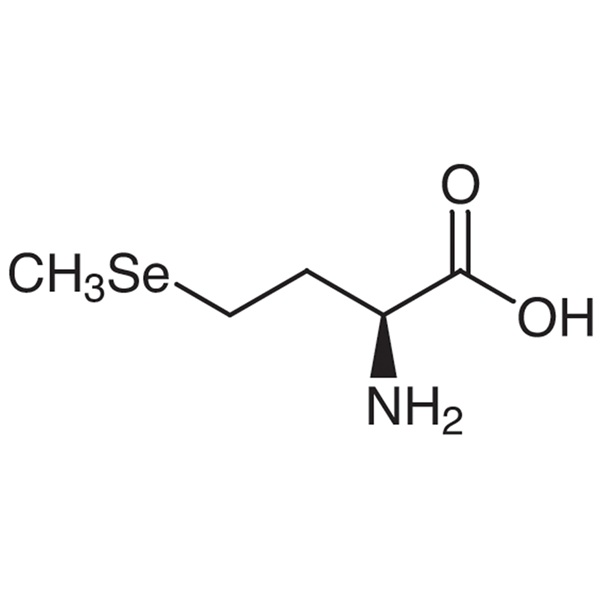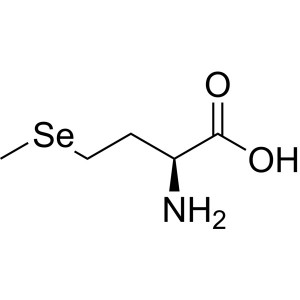L-Selenomethionine CAS 3211-76-5 Assay 97.0-103.0% (HPLC)
Shanghai Ruifu Chemical Co., Ltd. is the leading manufacturer of L-Selenomethionine (CAS: 3211-76-5) with high quality. Ruifu Chemical has been supplying amino acids and derivatives more than 15 years.
Ruifu Chemical can provide worldwide delivery, competitive price, excellent service.
Purchase L-Selenomethionine or other products, please contact us by e-mail: alvin@ruifuchem.com
| Chemical Name | L-Selenomethionine |
| Synonyms | L-(+)-Selenomethionine; SEMET; Seleno-L-Methionine; H-L-SeMet-OH; (S)-2-Amino-4-(Methylseleno)butyric Acid |
| Stock Status | In Stock, Commercial Production |
| CAS Number | 3211-76-5 |
| Molecular Formula | C5H11NO2Se |
| Molecular Weight | 196.11 g/mol |
| Melting Point | 263.0-266.0℃ |
| Store Under Inert Gas | Store Under Inert Gas |
| Sensitive | Air Sensitive, Hygroscopic, Heat Sensitive |
| Water Solubility | Soluble in Water (50 mg/ml) |
| Solubility | Soluble in Alcohol |
| Storage Temperature | Store Long-Term at 2-8℃ |
| COA & MSDS | Available |
| Origin of Product | Shanghai, China |
| Product Categories |
Amino Acids and Derivatives |
| Brand | Ruifu Chemical |
| Items | Specifications | Results |
| Appearance | White to Off-White Powder | Conforms |
| Infrared Spectrum | In Accordance with the Standard | Conforms |
| 1H NMR Spectrum | In Accordance with the Standard | Conforms |
| Assay / Analysis Method | 97.0-103.0% (HPLC) | 98.7% |
| Specific Rotation [α]20/D | +17.0° to +19.5° (C=10 mg/ml in 1N HCl) | +18.1° |
| Selenium (Se) | 39.0-41.0% | Conforms |
| D-Isomer Content | ≤0.05% | 0.02% |
| Arsenic (As) | ≤1ppm | 0.02ppm |
| Mercury (Hg) | ≤1ppm | Not Detected |
| Lead (Pb) | ≤3ppm | 1.2ppm |
| Heavy Metals | ≤10ppm | <10ppm |
| Water by Karl Fischer | ≤0.50% | 0.30% |
| Solubility | 50mg in 1mg Water Clear Soluble | Pass |
| Conclusion | The product has been tested and complies with the given specifications | |
Package: Bottle, Aluminium foil bag, 25kg/cardboard drum, or according to customer's requirement.
Storage Condition: Keep the container tightly closed. Store in a cool, dry (2-8℃) and well-ventilated warehouse away from incompatible substances. Keep away from sunshine; avoid fire and heat sources; avoid moisture.
Shipping: Deliver to worldwide by air, by FedEx / DHL Express. Provide fast and reliable delivery.
How to Purchase? Please contact Dr. Alvin Huang: sales@ruifuchem.com or alvin@ruifuchem.com
15 Years Experience? We have more than 15 years of experience in the manufacture and export of a wide range of high quality pharmaceutical intermediates or fine chemicals.
Main Markets? Sell to domestic market, North America, Europe, India, Korea, Japanese, Australia, etc.
Advantages? Superior quality, affordable price, professional services and technical support, fast delivery.
Quality Assurance? Strict quality control system. Professional equipment for analysis include NMR, LC-MS, GC, HPLC, ICP-MS, UV, IR, OR, K.F, ROI, LOD, MP, Clarity, Solubility, Microbial limit test, etc.
Samples? Most products provide free samples for quality evaluation, shipping cost should be paid by customers.
Factory Audit? Factory audit welcome. Please make an appointment in advance.
MOQ? No MOQ. Small order is acceptable.
Delivery Time? If within stock, three days delivery guaranteed.
Transportation? By Express (FedEx, DHL), by Air, by Sea.
Documents? After sales service: COA, MOA, ROS, MSDS, etc. can be provided.
Custom Synthesis? Can provide custom synthesis services to best fit your research needs.
Payment Terms? Proforma invoice will be sent first after confirmation of order, enclosed our bank information. Payment by T/T (Telex Transfer), PayPal, Western Union, etc.
Risk Codes R23/25 - Toxic by inhalation and if swallowed.
R33 - Danger of cumulative effects
R50/53 - Very toxic to aquatic organisms, may cause long-term adverse effects in the aquatic environment.
Safety Description S20/21 -
S28 - After contact with skin, wash immediately with plenty of soap-suds.
S45 - In case of accident or if you feel unwell, seek medical advice immediately (show the label whenever possible.)
S60 - This material and its container must be disposed of as hazardous waste.
S61 - Avoid release to the environment. Refer to special instructions / safety data sheets.
S28A -
UN IDs UN 3283 6.1/PG 2
WGK Germany 3
RTECS EK7713840
FLUKA BRAND F CODES 10
HS Code 2922491990
Hazard Class 6.1
Packing Group III
L-Selenomethionine (CAS: 3211-76-5) is a derivative of the amino acid methionine that has been extensively used in the field of pharmaceutical development and drug discovery research.
Selenomethionine
C5H11NO2Se 196.11
(S)-2-Amino-4-(methylselenyl)butyric acid [1464-42-2].
DEFINITION
Selenomethionine contains NLT 97.0% and NMT 103.0% of selenomethionine (C5H11NO2Se) and contains NLT 39.0% and NMT 41.0% of selenium (Se), calculated on the as-is basis.
IDENTIFICATION
• A. Infrared Absorption <197K>
ASSAY
• Procedure
Mobile phase: 6.8 g/L of monobasic potassium phosphate in water. Adjust with phosphoric acid to a pH of 2.75 ± 0.25.
System suitability solution: 0.16 mg/mL of USP Selenomethionine RS and 0.8 mg/mL of USP L-Methionine RS in Mobile phase
Standard solution: 0.16 mg/mL of USP Selenomethionine RS in Mobile phase
Sample solution: 0.16 mg/mL of Selenomethionine in Mobile phase with sonication. Pass through a membrane filter of 0.45-µm pore size.
Chromatographic system
(See Chromatography <621>, System Suitability.)
Mode: LC
Detector: UV 220 nm
Column: 4.6-mm × 25-cm; packing L1 with polar end-capping
Flow rate: 1 mL/min
Injection size: 20 µL
System suitability
Sample: System suitability solution
[Note-The relative retention times for methionine and selenomethionine are 0.8 and 1.0, respectively.]
Suitability requirements
Resolution: NLT 3.0 between methionine and selenomethionine
Tailing factor: NMT 2.0 for the selenomethionine peak
Relative standard deviation: NMT 2.0% for the selenomethionine peak
Analysis
Samples: Standard solution and Sample solution
Calculate the percentage of selenomethionine (C5H11NO2Se) in the portion of Selenomethionine taken:
Result = (rU/rS) × (CS/CU) × 100
rU= peak response from the Sample solution
rS= peak response from the Standard solution
CS= concentration of USP Selenomethionine RS in the Standard solution (mg/mL)
CU= concentration of Selenomethionine in the Sample solution (mg/mL)
Acceptance criteria: 97.0%-103.0% on the as-is basis
IMPURITIES
• Heavy Metals, Method I <231>: NMT 20 ppm
• Limit of Sodium
Standard stock solution: 10 µg/mL of sodium from sodium chloride, previously dried at 105 for 2 h
Standard solutions: 0.2, 0.5, and 1.0 µg/mL of sodium. Pipet 2.0, 5.0, and 10.0 mL of Standard stock solution into separate 100-mL volumetric flasks. To each flask add 2.0 mL of potassium chloride solution (1 in 5) and 1.0 mL of hydrochloric acid, and dilute with water to volume.
Sample solution: Transfer 100 mg of Selenomethionine to a 100-mL volumetric flask, add 2.0 mL of potassium chloride solution (1 in 5) and 1.0 mL of hydrochloric acid, and dilute with water to volume.
Instrumental conditions
(See Spectrophotometry and Light-Scattering <851>.)
Mode: Atomic absorption spectrophotometry
Analytical wavelength: 589 nm
Lamp: Sodium hollow-cathode
Flame: Air–acetylene
Analysis
Samples: Standard solutions and Sample solution
Determine the absorbances of the solutions. Plot the absorbances of the Standard solutions versus their concentrations (µg/mL of sodium), and draw the straight line best fitting the plotted points. From the graph so obtained, determine the concentration of sodium, CNa (µg/mL), in the Sample solution.
Calculate the percentage of sodium in the portion of Selenomethionine taken:
Result = (CNa/CSA) × F × 100
CNa= concentration of sodium in the Sample solution (µg/mL), determined from the regression line
CSA= concentration of Selenomethionine in the Sample solution (mg/mL)
F= conversion factor, 0.001 mg/µg
Acceptance criteria: NMT 0.1%
• Chromatographic Purity
Standard solution A: Transfer 50 mg of USP Selenomethionine RS to a 10-mL volumetric flask, add 2 mL of water, warm to dissolve if necessary, and dilute with methanol to volume.
Standard solution B: Transfer 1.0 mL of Standard solution A to a 100-mL volumetric flask, and dilute with methanol to volume.
Sample solution: Transfer 50 mg of Selenomethionine to a 10-mL volumetric flask, add 2 mL of water, warm to dissolve if necessary, and dilute with methanol to volume.
Chromatographic system
(See Chromatography <621>, System Suitability.)
Mode: TLC
Absorbent: 0.25-mm layer of chromatographic silica gel mixture
Application volume: 10 µL
Developing solvent: Butanol, glacial acetic acid, and water (4:1:1)
Spray reagent: 2 mg/mL of ninhydrin in alcohol
Analysis
Samples: Standard solution A, Standard solution B, and Sample solution
Proceed as directed for Chromatography <621>, Thin-Layer Chromatography. Allow the spots to dry, and develop the chromatogram in the Developing solvent until the solvent front has moved three-fourths of the length of the plate. Remove the plate from the developing chamber, mark the solvent front, and allow the solvent to evaporate. Locate the spots on the plate by spraying with Spray reagent and drying it at 110 for 10 min.
Acceptance criteria: NMT 1.0%. The RF value of the principal spot of the Sample solution corresponds to that of Standard solution A; and no spot, other than the principal spot of the Sample solution, is larger or more intense than the principal spot of Standard solution B.
SPECIFIC TESTS
• Optical Rotation, Specific Rotation <781S>
Sample solution: 10 mg/mL in 1 N hydrochloric acid
Acceptance criteria: +17.0 to +19.5
• Content of Selenium
[Caution-Selenium is toxic; handle it with care.]
Standard stock solution: Dissolve 1 g of metallic selenium in a minimum volume of nitric acid. Evaporate to dryness, add 2 mL of water, and evaporate to dryness. Repeat the addition of water and evaporation to dryness three times. Dissolve the residue in 3 N hydrochloric acid, transfer to a 1000-mL volumetric flask, and dilute with 3 N hydrochloric acid to volume. This solution contains 1000 µg/mL of selenium.
Standard solutions: 20, 50, and 100 µg/mL of selenium. Pipet 2.0, 5.0, and 10.0 mL of Standard stock solution into separate 100-mL volumetric flasks. Dilute the contents of each flask with water to volume.
Sample solution: 0.125 mg/mL of Selenomethionine in water
Instrumental conditions
(See Spectrophotometry and Light-Scattering <851>.)
Mode: Atomic absorption spectrophotometry
Analytical wavelength: 196 nm
Lamp: Selenium hollow-cathode
Flame: Air-acetylene
Blank: Water
Analysis
Samples: Standard solutions and Sample solution
Determine the absorbances of the solutions. Plot the absorbances of the Standard solutions versus their concentrations (µg/mL of selenium), and draw the straight line best fitting the plotted points. From the graph so obtained, determine the concentration of selenium, CSe (µg/mL), in the Sample solution.
Calculate the percentage of selenium in the portion of Selenomethionine taken:
Result = (CSe/CSA) × F × 100
CSe= concentration of selenium in the Sample solution (µg/mL), determined from the regression line
CSA= concentration of Selenomethionine in the Sample solution (mg/mL)
F= conversion factor, 0.001 mg/µg
Acceptance criteria: 39.0%-41.0% on the as-is basis
ADDITIONAL REQUIREMENTS
• Packaging and Storage: Preserve in well-closed containers.
• USP Reference Standards <11>
USP L-Methionine RS
USP Selenomethionine RS
-
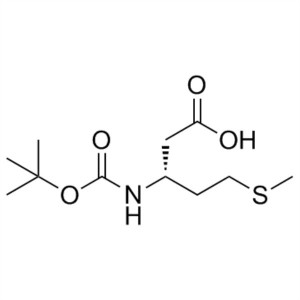
Boc-L-beta-Homomethionine CAS 244251-20-5 Assay...
-
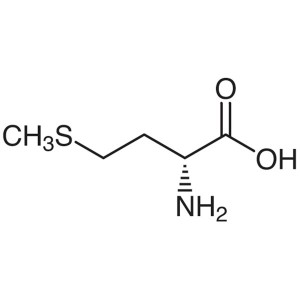
D-Methionine CAS 348-67-4 (H-D-Met-OH) Assay 99...
-
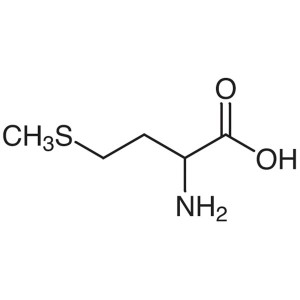
DL-Methionine CAS 59-51-8 (H-DL-Met-OH) Assay 9...
-
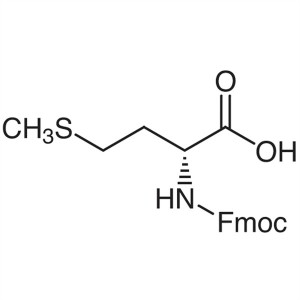
Fmoc-D-Met-OH CAS 112883-40-6 Fmoc-D-Methionine...
-
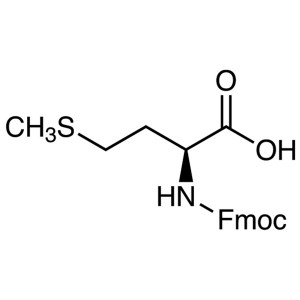
Fmoc-Met-OH CAS 71989-28-1 Fmoc-L-Methionine Pu...
-
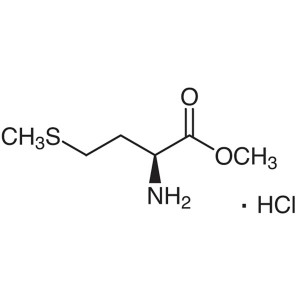
H-Met-OMe·HCl CAS 2491-18-1 L-Methionine Methyl...
-
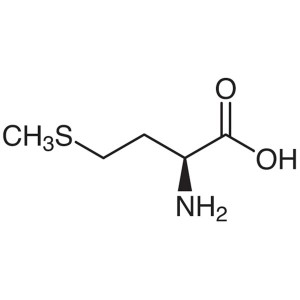
L-Methionine CAS 63-68-3 (H-Met-OH) Assay 99.0~...
-
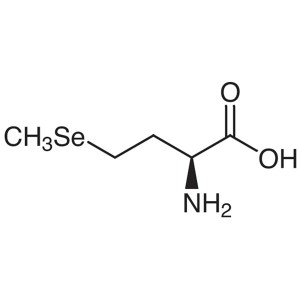
L-Selenomethionine CAS 3211-76-5 Assay 97.0-103...
-
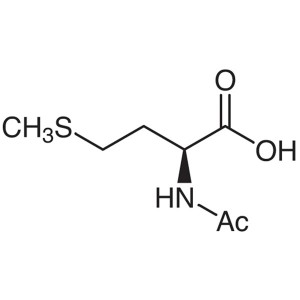
N-Acetyl-L-Methionine CAS 65-82-7 (Ac-Met-OH; N...
-
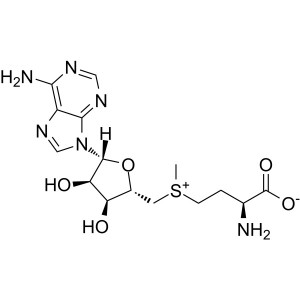
S-Adenosyl-L-Methionine (Ademetionine; SAMe) CA...

